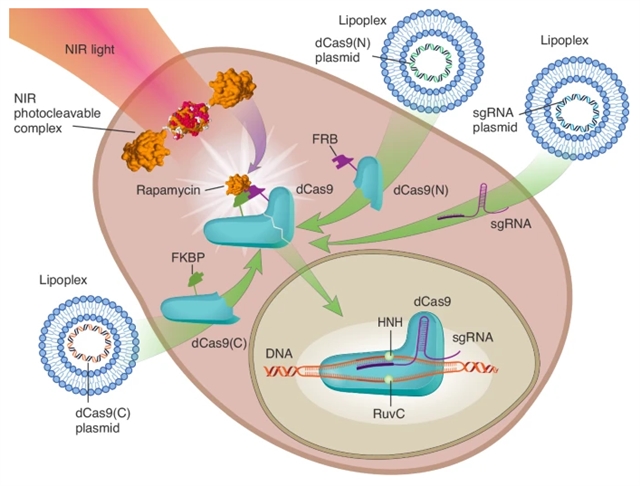
美国哈佛大学Perelman, Lev T.团队研究了近红外光可激活化学诱导CRISPR系统。2025年7月1日,《光:科学与应用》杂志发表了这一成果。
使用CRISPR技术的最大挑战是脱靶效应,这限制了它们在医学中的广泛应用。原则上,这些影响可以通过确保CRISPR主要在靶细胞中激活来最小化,从而降低非靶组织中意外基因修饰的可能性。因此,开发一种可光激活的CRISPR方法来在空间和时间上动态控制基因激活将是非常有益的。 一个缺点是,最近推出的绝大多数可光激活的CRISPR系统需要紫外线或蓝光照射,严重限制了CRISPR可以激活的组织中光的穿透深度,并且在紫外线的情况下,引发了安全问题。
少数使用较长波长激活CRISPR的系统受到缓慢的光激活或与拟议技术在人体中的毒性和生物相容性相关的问题的阻碍。为了解决这个问题,研究组开发了一种分裂-Cas9/dCas9系统,其中通过近红外光可清除的二聚化复合物实现激活。这种光活化方法可以在人体内安全使用,很容易适应不同的分裂-Cas9/dCas9系统,并能够在各种细胞类型中实现快速、空间精确的光活化。
附:英文原文
Title: Near-infrared light activatable chemically induced CRISPR system
Author: Zhang, Lei, Zhang, Xuejun, Qiu, Le, Mao, Song, Sheng, Jia, Chen, Liming, Khan, Umar, Upputuri, Paul K., Zakharov, Yuri N., Coughlan, Mark F., Perelman, Lev T.
Issue&Volume: 2025-07-01
Abstract: The biggest challenge in using CRISPR technologies, which limits their widespread application in medicine, is off-target effects. These effects could, in principle, be minimized by ensuring that CRISPR is activated primarily in the targeted cells, thereby reducing the likelihood of unintended genetic modifications in non-target tissues. Therefore, the development of a light activatable CRISPR approach to dynamically control gene activation in both space and time would be highly beneficial. A drawback is that the overwhelming majority of recently introduced light activatable CRISPR systems require UV or blue light exposure, severely limiting the penetration depth of light in tissue at which CRISPR can be activated, and, in the case of UV light, raising safety concerns. A small number of systems that activate CRISPR using longer wavelengths are hindered by either slow light activation or issues related to toxicity and biocompatibility of the proposed techniques in humans. To address this, we developed a split-Cas9/dCas9 system in which activation is achieved through a near-infrared photocleavable dimerization complex. This photoactivation method can be safely used in humans in vivo, easily adapted to different split-Cas9/dCas9 systems, and enables rapid, spatially precise light activation across various cell types.
DOI: 10.1038/s41377-025-01917-8
Source: https://www.nature.com/articles/s41377-025-01917-8
Light: Science & Applications:《光:科学与应用》,创刊于2012年。隶属于施普林格·自然出版集团,最新IF:19.4
官方网址:https://www.nature.com/lsa/
投稿链接:https://mts-lsa.nature.com/cgi-bin/main.plex
